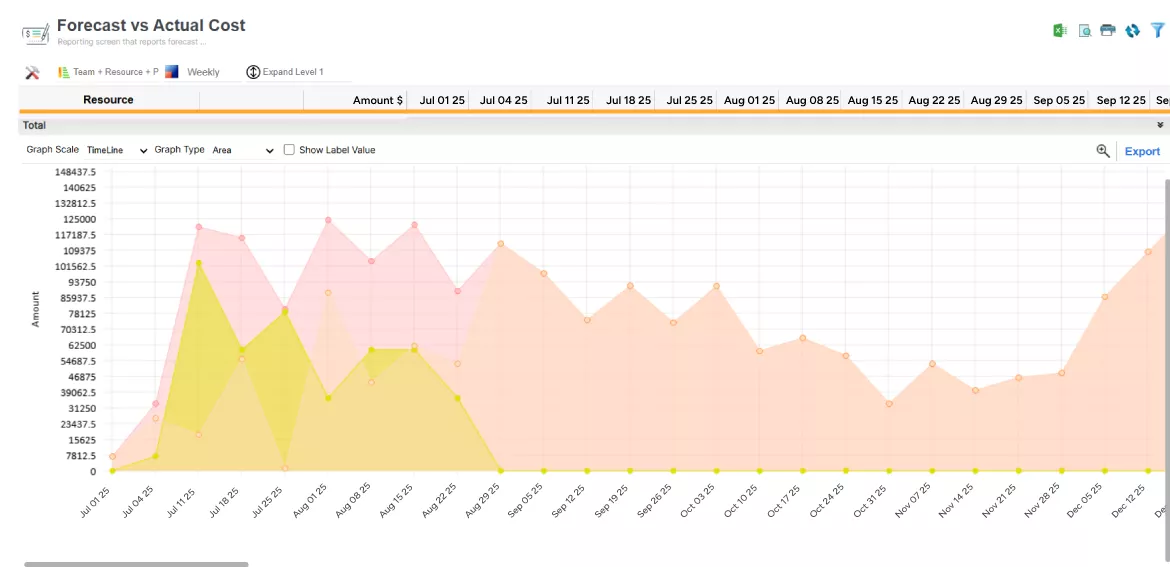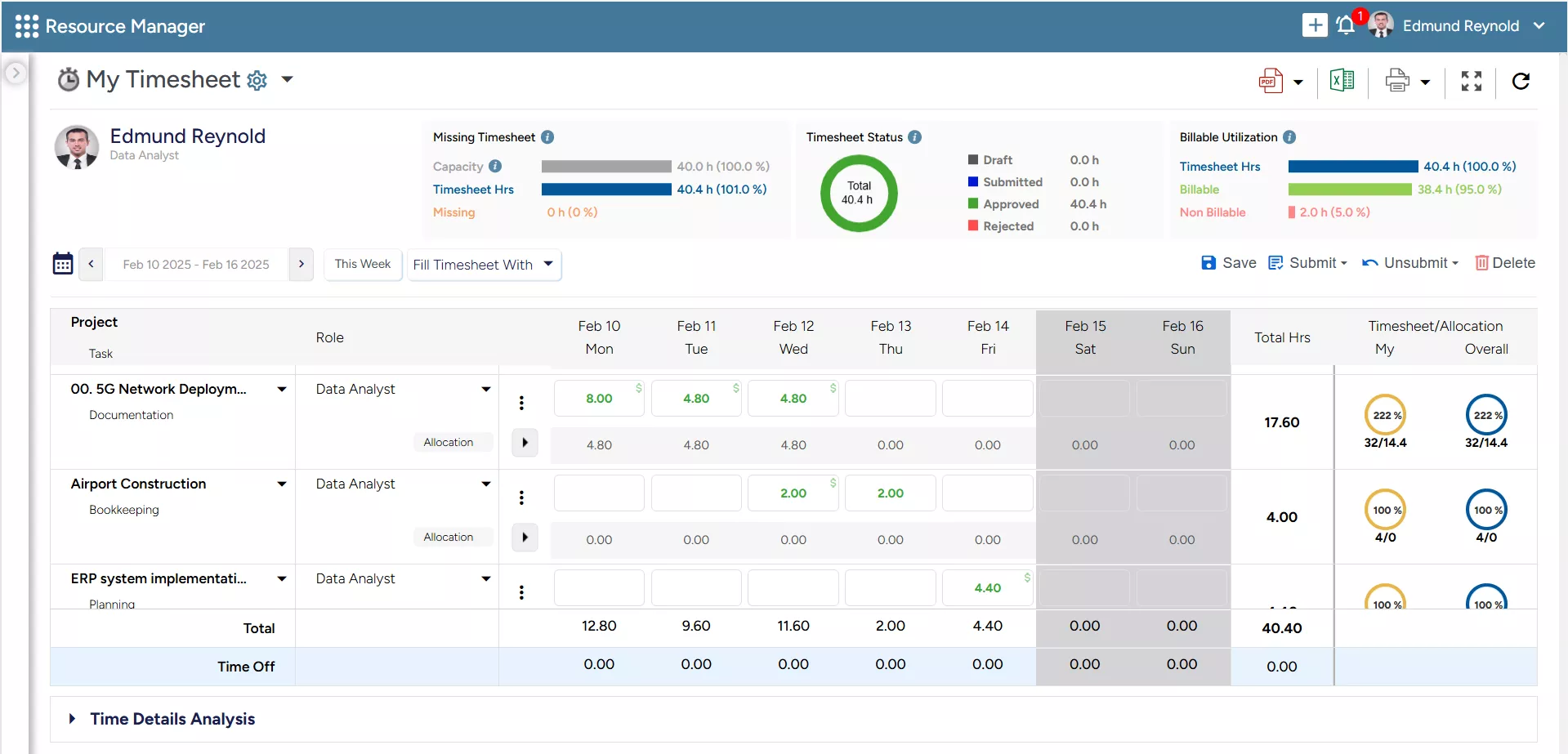Do you struggle to track your project’s progress while navigating silos of multiple spreadsheets, emails, and applications?
If yes, it’s time to switch over to advanced project reports. These reports provide visibility into critical project KPIs such as time, cost, scope, and resources, allowing managers to monitor project progress and act proactively. In the absence of real-time project reports, it is challenging to track variances, leading to budget overruns and, ultimately, project failures.
Furthermore, project reports provide a consolidated view of quantifiable metrics and the overall project health. Thus, they allow project managers to track progress, identify risks, and make informed decisions. Beyond that, reports enhance transparency by facilitating timely dissemination of project-specific information to everyone involved. Therefore, creating and maintaining reports is a critical part of successful project management.
This blog discusses what project reports are, their different types, and the steps on how to create effective project reports.
But first, let’s begin with the basics.
What are Project Reports?
Project reports are structured documents that provide detailed insights into a project’s performance, progress, and other key metrics. They represent these data in an easy-to-comprehend format. Based on that, managers and stakeholders can identify bottlenecks and take timely remedial actions to maintain the project health index.
Project reports typically include information such as objectives, timelines, resource usage, challenges faced, and outcomes achieved. Moreover, they convey the project’s current status to its readers and serve as a formal record of the entire lifecycle.
Now, let’s understand the various components of project reports
Components of Project Report
Project reports consist of essential information needed to lead the project effectively. Below are the main components of project reports –
Executive Summary
The executive summary is the first element included in project reports. It contains a brief overview of the project, summarizing all the findings for immediate understanding of stakeholders, executives, or team members. It is typically written in two or three paragraphs.
Introduction
The introduction section sets the stage for the project report and explains the background and rationale of the project. It mainly discusses the objectives, project scope, and purpose, providing an overview of what can be expected in the project report.
Objectives
This section outlines the goals and deliverables, ensuring all stakeholders understand the project’s purpose, expected outcomes, and key deliverables. It also makes certain that all team members are working towards the same goal.
Methodology
The project management methods, technologies, and research techniques used throughout the lifecycle are mentioned in this section. It includes key information regarding the tools and frameworks utilized during implementation.
Read More: Top 14 Project Management Methodologies: Tips to Choose the Right One
Budget and Timeline
The timeline and budget needed to complete the project are discussed under this component. It provides an overview of the schedule and the fund allocation for human, material, and machinery resources.
Findings/Analysis
The results obtained from the detailed project analysis are included in this section. It highlights trends, patterns, and critical observations, which can be supported with tables, charts, graphs, or other visual aids to enhance clarity.
Project Implementation
Under this section, the process of how a project was put into action to achieve the desired results is included. It elaborates on implementation strategy, resource allocation, timeline, milestones, challenges, and solutions.
Risk Analysis
It covers setbacks that may arise during the project, such as budget constraints, scope changes, or resource unavailability. Moreover, this section also highlights the likelihood of these project risks, mitigation strategies, and monitoring mechanisms.
Performance Evaluation
This section of the report provides an overview of the project’s outcomes against its objectives. It mainly covers performance metrics, success criteria, lessons learned, stakeholder feedback, and impact analysis.
Conclusion
The conclusion section is the final component of the project report. It reiterates the project’s objectives, highlights the most significant results, summarizes achievements, and outlines the potential next steps.
The following section discusses some essential project reports that managers should know.
Types of Project Reports
There are various reports that are created during a project’s lifecycle based on their specific needs. Enlisted below are the twelve most important project reports:
Project Status Report
As the name suggests, these project reports enable the stakeholders to understand the overall status. It clarifies whether the project is going as planned or if there are any variances or hiccups during the journey. With these reports, one can review the completed work, the remaining work, overall completion rate, issues, key project milestones achieved, budget utilization, etc.,
Project Progress Report
A project progress report is a more detailed version of the status report that helps compare the completed work against the planned tasks. It typically consists of accomplished tasks, in-progress activities, and upcoming milestones. These project reports also provide an overview of the team’s workload management and outline any bottlenecks that may impact delivery.
Risk Report
A risk report summarizes unforeseen circumstances that could derail the project and affect the timeline, budget, and deliverables. It also documents mitigation strategies and assigns risk owners responsible for monitoring and addressing these risks. Thus, these project reports serve as a vital communication tool and help the stakeholders within the project to ensure continuous risk management.
Project Budget Report
The project budget report provides insights into the initial fund estimate, actual expenditure, budget variance, cost overruns, and their causes. It also includes an expense breakdown highlighting the allocation of funds to different project activities. Further, as the project moves to different phases, managers can compare the planned vs. actual expense with the help of this report.
Read more: How to Develop an Effective Project Budget in 8 Simple Steps?
Project Variance Report
There are three essential baselines for any project. These are the scope, cost, and time baseline. A variance/baseline report helps compare the actuals with the approved baselines with project metrics like Scope Variance, Cost Variance (CV), and Schedule Variance (SV). Thus, managers can identify the deviations and take course-corrective actions when necessary.
Board/Executive Report
Board/executive reports would be used by the upper management or the C-level executives for decision-making. Since the board members do not have much time on their plate, these reports need not have a granular representation of the whole project. Instead, these project reports should comprise high-level information relevant to the executives.
Gap Analysis Report
The gap analysis report is used to identify the discrepancies between current project performance and desired objectives. The key components of the gap analysis report include current state vs. expected outcome, reasons behind performance gaps, strategies to overcome gaps, and KPIs used to measure improvement. Thus, this report aids in performance optimization.
Time Tracking Report
Time tracking reports allow project managers to record and document the time spent by the team members on each project activity. It provides a breakdown of the hours worked per task. Moreover, it helps compare planned vs. actual task duration and identify time-related bottlenecks. Thus, it serves as a valuable tool for efficient resource scheduling in time-sensitive projects
Read More: What is Time Management? 9 Effective Strategies to Master It
Cost Benefit Analysis Report
The cost-benefit analysis report compares the expected project budget against the anticipated benefits. This report offers detailed insights into the breakdown of expenses, financial and non-financial gains, break-even analysis, and ROI. Thus, it helps sponsors or stakeholders to evaluate the project’s profitability and value.
Project Performance Report
Performance reports are used to assess the overall success of a project based on the pre-established key performance indicators. It comprises details such as overall time and cost invested in the completion of a project. It also evaluates project deliverables and their quality, highlights clients’ satisfaction levels, and lists lessons learned for future projects.
Project Completion Report
A project completion report summarizes the overall progress, achievements, and final outcomes of a project. It provides details on key milestones, schedule adherence, timeline summary, stakeholder feedback, and any challenges encountered. This report serves as a formal closure document, ensuring all objectives are met, and recommendations are recorded for future projects.
Resource Report
A resource report provides pertinent information about the project teams and members. It outlines resource allocation, team assignments, equipment and materials used, utilization rate, and skill shortages. Besides, one can also visualize if some resources are taking unplanned leaves or taking too much time to complete any task.
Read More: What is Resource Allocation, and Why is it Important?
Now that we know the different types of project reports, let us understand them more deeply with an example.
Project Report Example
Let’s dive into the details of project reports with an example. Consider you are a project manager of a construction firm that has undertaken a project to build a 10-floor, 100-apartment housing project in Hawkins, Indiana. Below is the project progress report created for the same:
Project Report: Sunshine Residential Complex
Project Manager: Richard Jones
Client: Sunshine Developers Pvt Ltd.
Location: Hawkins, Indiana
Start Date: 02-06-2024
Completion Date: 06-09-2025
Status: In Progress
1. Project Overview
The Sunshine Residential Complex is a 10-floor building with 100 apartments. The project is underway, aiming to deliver affordable housing by September 2025.
2. Timeline
- Site Preparation: Completed
- Foundation Work: 60% complete
- Structure Construction: Pending
- Interior Finishing: Pending
3. Budget
The total budget is allocated at $2,000,000, with expenses for material and labor costs currently at $800,000 and $600,000, respectively, remaining within the planned limits.
4. Risks & Mitigation
- Supply Delays: Mitigated by early procurement.
- Safety Hazards: Addressed through enhanced training and frequent inspections.
5. Progress
- Site Prep: Done
- Foundation: 60% complete
- Structure: Materials ordered
- Interior: Design review in progress
6. Current Challenges
- Weather Delays: Unpredictable weather conditions affecting the workplace
- Labor Shortages: Efforts underway to recruit additional workforce
7. Next Steps
Finishing the structure by February 2025.
Starting interior work by March 2025.
Now, let us understand why project reports are important.
Read More: Project Initiation: Nine Effective Steps to Kick-off Projects the Right Way
Importance of Project Reports
First and foremost, without proper and effective project reports, the decision-makers will be unable to track its progress and predict the final outcome. As a result, the entire project can come to a tumbling halt due to the lack of visibility of relevant data.
Here are a few more reasons why project reports are crucial:
- It provides a high-level overview of the project at every stage so that the team leads can correct any deviations.
- With progress reports, stakeholders can track the current project status and compare it with the original plan.
- Reports such as the project budget give a clear picture of what has been achieved for the cost incurred at every milestone.
Now that we have understood the importance of project reports, let us explore how to write effective project reports.
How to Write an Effective Project Management Report?
A well-documented project report provides clarity on the project’s status, helps communicate updates to stakeholders, and guides necessary adjustments to ensure success. Below are the steps to create an effective project report:
Define the Objective of the Report
There are different types of project reports, and each comes with a distinct objective. Thus, the first step in creating the project report is to establish a clear purpose to ensure it remains aligned with the intended outcomes. For example, the report may be created to request additional resources or simply provide a status update.
Clearly defining the objective of the project report at the outset helps structure the content appropriately. It also aids in incorporating relevant insights and omitting unnecessary details, making the report more focused, concise, and impactful.
Understand Your Target Audience
The next step includes understanding the audience to whom the project report is being sent and knowing their concerns. Tailoring the content to the right audience enhances clarity and relevance. For example, senior executives and board members often prefer a high-level overview of project milestones and budget implications.
On the other hand, for project managers, the report must incorporate detailed insights into task progress and resource allocation. It is also important to make sure that simplified language is used for non-technical users and that technical details such as programming language or framework are added for operational teams.
Read More: Project Milestones: How to Manage Them Effectively for Project Success?
Centralize the Project Data
Next, project managers can bring all the related data into one place as it is the most essential input when creating project reports. This process involves gathering information from project management software, resource timesheets, performance tracking tools, and expense records.
The centralized repository minimizes redundancies and saves time during report compilation. Further, it enables the report writer to present a holistic view of the project and enhances the report’s credibility.
Summarize the Project Health
Next, the collected data can be compiled to provide a brief overview of the project’s status. This section highlights key aspects such as progress, budget, risks, and team performance. Further, visual status indicators can be used to indicate the status, such as green for on track, yellow for risk, or red for delayed.
Moreover, KPIs such as achieved milestones, budget consumption, and resource utilization rate can be briefly mentioned here. This helps decision-makers assess the current progress of the project and identify if immediate attention is required.
Read More: What is Resource Utilization? A Complete Guide to Improve Business Efficiency
Provide an Overview of Key Areas
The subsequent step involves summarizing the most important aspects of the project, such as scope, budget, timeline, and resources. For example, the scope section explains the current status of project deliverables and deviations, if any. The schedule component outlines adherence to deadlines.
Furthermore, the budget section highlights planned vs. actual expenditures, while the resource segment assesses whether the workforce, tools, and raw materials are being effectively utilized. This provides a thorough understanding of the project’s overall health.
Highlight Any Potential Bottlenecks
The next section in the project report highlights roadblocks that may disrupt the project workflow, such as technical difficulties, resource constraints, limited budget, delayed timelines, and so on. While mentioning bottlenecks, explaining their impact on the timeline, budget, and deliverables is crucial.
Outlining potential bottlenecks early informs decision-makers and stakeholders about the challenges that can delay project delivery or hamper its quality. It also helps in developing risk management strategies to address issues before they escalate.
Read More: Enterprise Risk Management Framework: 8 Core Components
Add Links to Other Project Documents
Project managers can add links to relevant documents in the report to enhance its utility. Moreover, adding links to supporting documents such as the project scope document, project plan, Gantt Charts, and risk register can offer deeper insights without cluttering the report.
Incorporating these links makes the report extensive and enhances the efficiency of information retrieval. It also promotes transparency by enabling stakeholders to verify facts and cross-check data if needed.
Include Actionable Recommendations
A project report is not created just to provide information; it should also guide board members and clients toward the next steps. Thus, after adding all the relevant project details, it is essential to provide actionable recommendations to help decision-makers take tangible steps.
For example, recommendations can include reallocating resources, or hiring contingent workers to mitigate resource-centric challenges, or adjusting deadlines to prevent delays. Moreover, it is crucial to provide practical and specific suggestions based on the data presented in project reports.
Read More: What is a Contingent Worker? Examples, Benefits & Best Practices
Structure & Format the Report
Lastly, structuring project reports appropriately is crucial to ensure the information is easily comprehended. A well-formatted report helps stakeholders quickly locate key details and assess the project’s status. The report should follow a logical sequence, beginning with an executive summary and objectives.
Moreover, you can further improve readability and concisely present information by adding headings, subheadings, tables, and bullet points. Finally, it is important to format reports correctly by maintaining a consistent font style, adequate spacing, and error-free language throughout the document.
Now that we have understood how to write effective project reports, let us move on to the best practices to follow while creating one.
Best Practices for Creating Project Reports
Let’s consider that you are heading a project and want your business/data analysts to prepare reports for you. Here is the rundown of the ways through which they can create them effectively:
Formulate the Report as per the Audience
The nature of project reports differs according to the audience reviewing them. Since most of the reports will be created for the clients and the senior management, they need not be very technical. One must keep them compact with bullet points and visuals and avoid jargon wherever possible.
Ensure the Data Gathered is Relevant & Up-to-Date
Ensuring that the information in project reports is up-to-date is crucial for informed decision-making. Therefore, project managers can collect data from reliable sources such as project management tools or financial records. Moreover, data should align with the report’s objectives.
Read More: How Can You Make Data-Driven Decisions with Resource Management Software?
Apply Visuals or Graphics for Better Comprehension
A text-heavy report may seem boring to some people. At the same time, the senior management won’t have time to glance through every word in the reports and understand the information. Thus, you should include illustrations, graphs, charts, etc., wherever possible to make the project reports visually appealing and more understandable.
Keep the Report Open for Comments
Project reports shouldn’t be just static documents that contain facts. Rather, they should encourage conversations between the people involved in the project. Project stakeholders or team members should be able to understand the reports and provide feedback and insights. Communicative project reports allow you to find the best solution for addressing any issue.
Read More: Who are Project Stakeholders? 7 Effective Ways to Manage Them
Create a Reporting Calendar
Just like the resource or the project schedule, a reporting calendar or timeline will help you create relevant reports from time to time and form a cadence. Moreover, with a proper schedule, everyone will know when to expect the project reports or updates. The senior management can even book time slots for these meetings to avoid any delays and make timely decisions to keep the project on track.
Now that we have understood the key guidelines for creating a project report, let us explore how a robust project resource management tool can help further.
How Can a Project Resource Management Tool Help Create Reports?
By utilizing SAVIOM’s futuristic project resource management tool, managers can enhance reporting accuracy and efficiency. Here’s how:
- The tool’s 360-degree resource visibility provides detailed insights into current and future schedules, ensuring optimal resource allocation across global projects.
- The multi-dimensional resource scheduler offers quick updates on task progress and staff workloads.
- Real-time BI reports provide granular insights into resource availability, utilization, and other key metrics.
![]()
SAVIOM’s Utilization Tracking Dashboard with color-coded heatmaps provides a quick overview of resource workload.
- The actual vs. forecast report compares the planned (forecasted) resource utilization, costs, or timelines against the actual data recorded during project execution.

SAVIOM’s Actual vs. Forecast report helps compare the actual vs. planned data to track variances.
- A project vacancy report highlights unfilled roles within a project, enabling managers to address resource shortages and skills proactively
- The people on the bench report offers the list of team members who can land on the bench, helping managers minimize idle time.
- Lastly, the integrated timesheets feature allows managers to track the time spent on tasks, providing valuable insights into resource productivity.

SAVIOM’s Integrated Timesheet helps track the time spent by resources on various tasks and analyze productivity.
Conclusion
Project reports are vital components of a project. They help communicate relevant and timely information to key stakeholders, strengthen decision-making, and ultimately ensure the successful delivery of projects. The reports mentioned above serve all these purposes, and thus, managers must get a clear understanding of them.
The Glossary
Read More: Glossary of Resource Workforce Planning, Scheduling and Management












